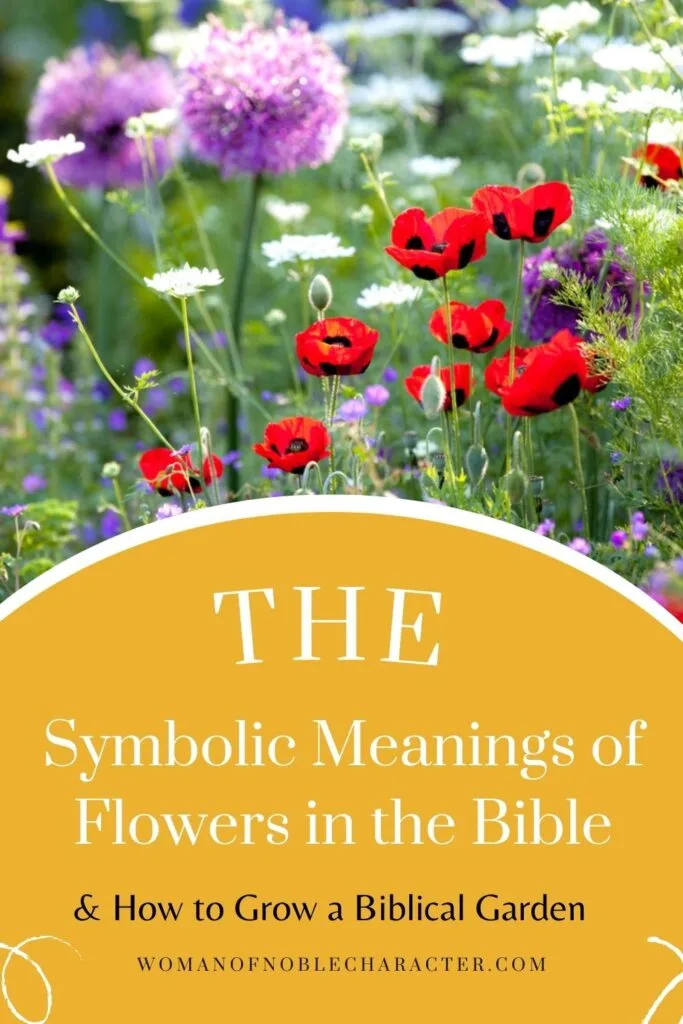This page/post may contain affiliate links. As an Amazon Associate, as well as an affiliate of other programs, this means if you purchase something using these links, I will receive a commission on qualifying purchases at no cost to you! For more detailed information, please visit our Affiliate Disclaimer page
By embracing Christian symbolism, followers of Christ could find solace in everyday experiences. Throughout the Bible, various kinds of flowers are referenced; their presence reminds us that faith is rooted even in something as beautiful and simple as a blossom. Symbolism has been woven into Christianity to restore and strengthen our confidence – because the purest forms of faith never need symbols to thrive!
Ancient people in Palestine were very familiar with a variety of plants, thanks to the dry climate – from figs and pomegranates to olive trees and vines. Wheat was their staple food for making bread, but barley provided sustenance for those who weren’t as well off. Jesus used these everyday sights when crafting his parable of the sower – an example that even thorny shrubs could bring forth beauty despite their sharp edges!
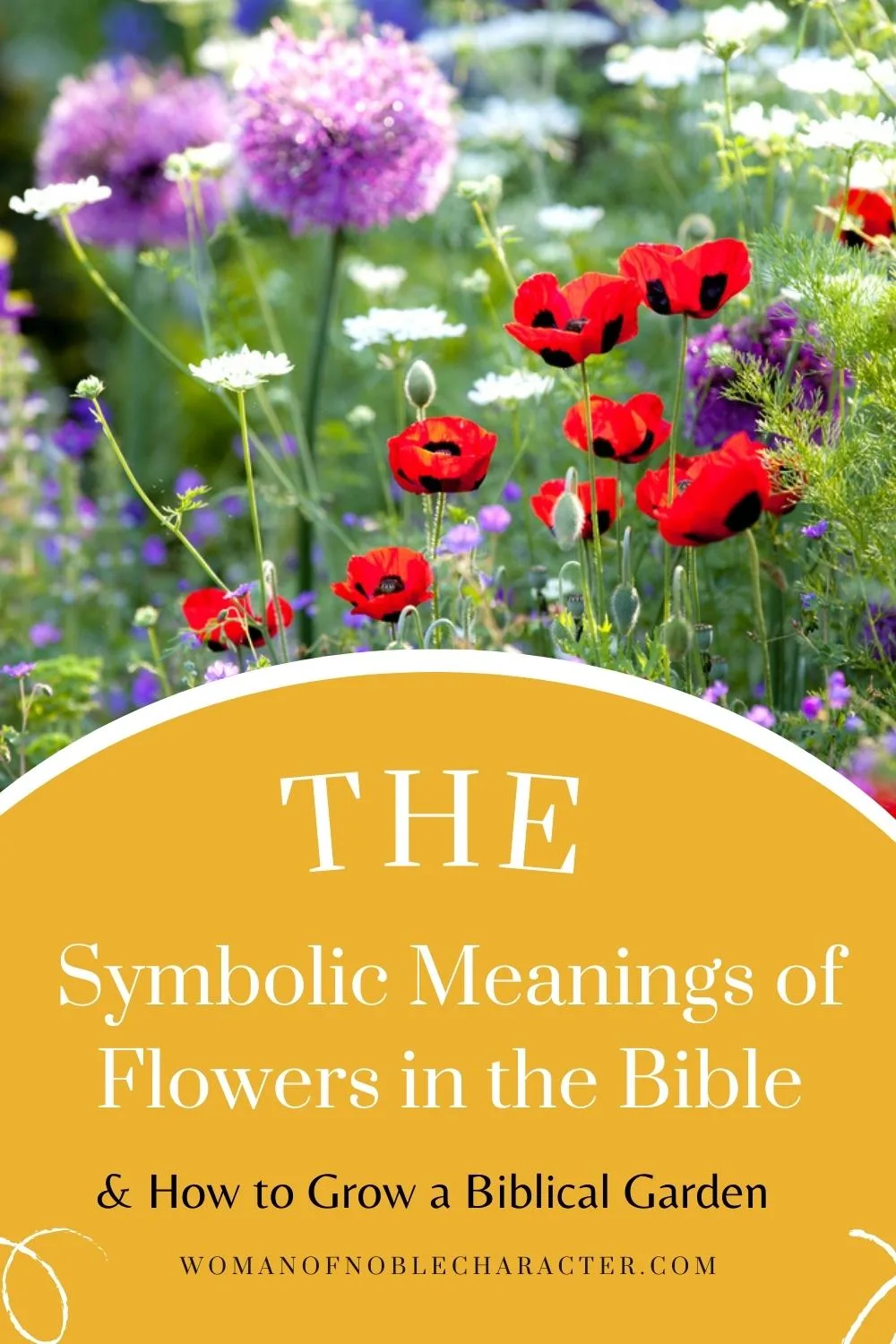
The thick thorns that crept up around the farmland eventually blocked out the delicate wheat seedlings. In Biblical times, these plants were seen as a symbol of wickedness – so much so that any nefarious deeds would be likened to gathering them and having them set ablaze.
If you missed the previous posts on Flowers in the Bible and Flowers in the Bible and Their Meanings (Anemone to Hyssop), you can check them out.
Below, we round out the list of Flowers in a biblical garden
And the symbolic meaning of flowers in the Bible
Laurel (Laurus nobilis)
(commonly known in modern society as bay leaves and mentioned often in the Bible as a crown or crowns as the leaf had been used to weave crowns)
I have seen a wicked, ruthless man,
Psalm 37:35 (ESV)
spreading himself like a green laurel tree.
An athlete is not crowned unless he competes according to the rules.
2 Timothy 2:5 (ESV)
Blessed is the man who remains steadfast under trial, for when he has stood the test he will receive the crown of life, which God has promised to those who love him.
James 1:12 (ESV)
David mentions the small tree (or shrub) once in Psalms, and Paul, Peter, and James reference the crowning laurel wreath in their writings.
Derivation of the botanical name:
Laurus, laurel.
nobilis, notable, famous.
The Hebrew name: ער, ar is in the Talmud, the plant is referred to as “Trepa Dera” in Aramaic.
The Latin name of the genus ar, Laurus (awake), derives from the name of laura, which means a place of monasticism for monks.
“The tree was especially reserved for triumphs and is certainly much favoured in houses; it is the guardian of the doorways of emperors and high priests, where it hangs alone adorning their homes and keeping a vigil before the treshold. Visitors to Delphi are crowned with laurel, as are generals celebrating a triumph at Rome.
The laurel itself is a messenger of peace, inasmuch as holding out a branch of laurel, even between enemy armies, is a sign of a truce”.
Pliny the Elder, Gaius or Caius Plinius Secundus, (23CE –79 CE) wrote in Naturalis Historia
Native to the sunny Mediterranean, bay laurel is a fragrant evergreen shrub or small tree that belongs to the Laurel family.
In the Holy Land, the Laurus nobilis is part of Israel’s beautiful Common Oak Forests. (Quercus calliprinos)
It is part of the Lauraceae family, which also includes sassafras, avocado, and cinnamon.
Wild plants can tower 6 feet tall, but when potted, they usually top out at 5 feet. Their glossy leaves are a deep green hue, leathery, and measure between two to four inches long with an elliptical or oval shape.
When spring takes over, the leaf axils of various plants are suddenly adorned with clusters of vibrant yellow-green male and female flowers. These flowers catch the eye with their stark absence of petals but draw you in further when tiny dark purple or black berries appear on female plants.
Uses of Lauris Nobilis
- Dried Laurus nobilis leaves are an essential seasoning in European cooking, adding a delicious flavor to everything from desserts to savory dishes
- Preserving dried figs and licorice gets extra protection thanks to the addition of one surprising ingredient – bay leaves! Acting as a natural pest repellent, these little pieces of foliage help thwart any weevils.
- They have been used in naturopathic medicine to treat skin diseases and cancer.
- The ancient Greeks used wreaths made from laurus nobilis leaves as crowns for champions of games.
- Pruning bay leaf trees into fun shapes like lollipops are not only visually appealing, but also provides a bit of excitement to your garden or backyard.
The form you have selected does not exist.
Lilly (Lilium)
And why are you anxious about clothing? Consider the lilies of the field, how they grow: they neither toil nor spin,
Matthew 6:28 (ESV)
I will be like the dew to Israel;
Hosea 14:5 (ESV)
he shall blossom like the lily;
he shall take root like the trees of Lebanon;
hey neither toil nor spin,
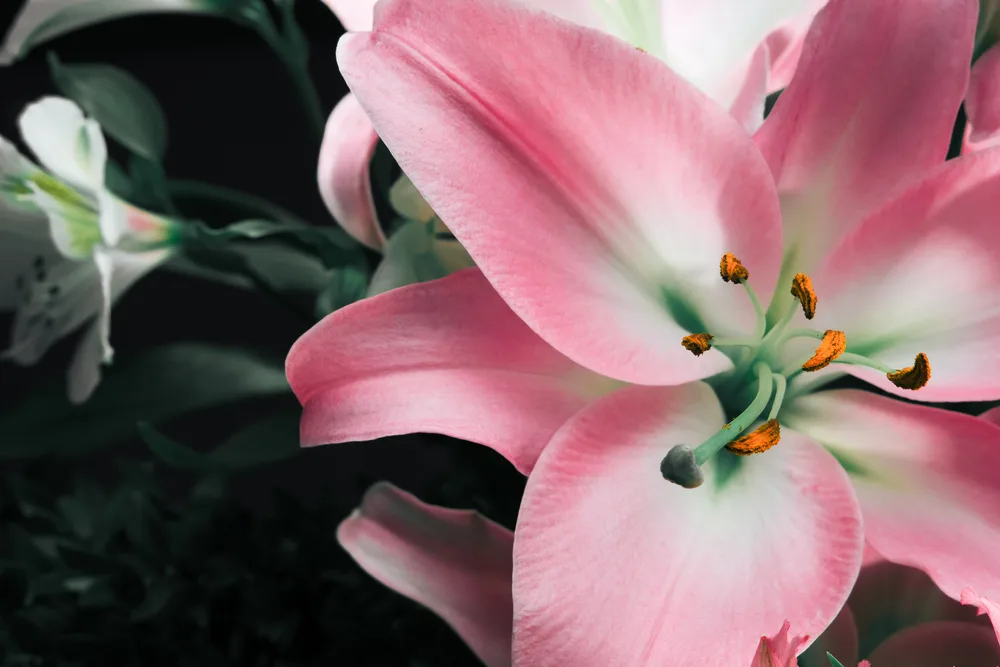
Derivation of the botanical name:
Lilium, Latin li, white; +lium, flower; Greek leirion, the name applied to the eastern Mediterranean Lilium candidum (candidum, meaning shining or pure white.)
The Hebrew word Shoshan (shushan) from Aramaic: shoshanta, שושנתא (rose); Arabic: susin (iris); Greek: souson; translated as “lily” means beautiful flower.
This gorgeous flower holds a secret and it is perfect for your biblical garden – it derives its name from the root for “six,” which is also reflected in its six petals. To form an alluring geometric shape, three outer ones, known as sepals, makeup two parts of this hermaphrodite flower into a hexagram.
“Susan” is translated from Shushana and means lily of the valley.
There are many references to “lily” in the Bible, including Lilium candidum, Anemone coronaria, Hyacinthus orientalis, Iris pseudacorus, Lilium chalcedonicum, and Nymphaea alba.
When exploring the wilds of nature, you may stumble upon Lilium candidum – known best as `the lily of the dark woods’ and Hyacinthus orientalis – otherwise dubbed ‘the lily of the grassy fields.’ These two beautiful blooms make a stunning addition to any biblical garden.
The Israelites held the lily in high regard, cherishing its fragrance so much that it even made for an alluring perfume.
In Hebrew poetry, they were seen as a powerful symbol of purity and innocence.
The white lily is truly a biblical star and should be in most biblical gardens- found eight times in the Song of Solomon and mentioned more than any other flower throughout Scripture.
King Solomon referred to the lily of the valleys, shoshanat haa’maqim, in his Song of Songs 2:1.
I am a rose of Sharon,
Song of Solomon 2:1 (ESV)
a lily of the valleys.
During the ancient sacrificial ritual, one could offer a tribute of fragrant lilies and roses as they processed around the altar – an aromatic offering to show honor and gratitude.
The lily is considered the flower of Christianity.
The beautiful lily cross is a meaningful symbol of Mary’s compassionate embrace as she experienced her son’s suffering alongside him.
The beautiful lily is a lasting fixture in the landscapes of Palestine, with wild varieties still taking root around western Galilee and Mount Carmel. It’s amazing to think that this flower has been blooming there for centuries!
Mallow (Malva moschata)
they pick saltwort and the leaves of bushes,
Job 30:4 (ESV)
and the roots of the broom tree for their food.
Can that which is tasteless be eaten without salt,
Job 6:6 (ESV)
or is there any taste in the juice of the mallow?
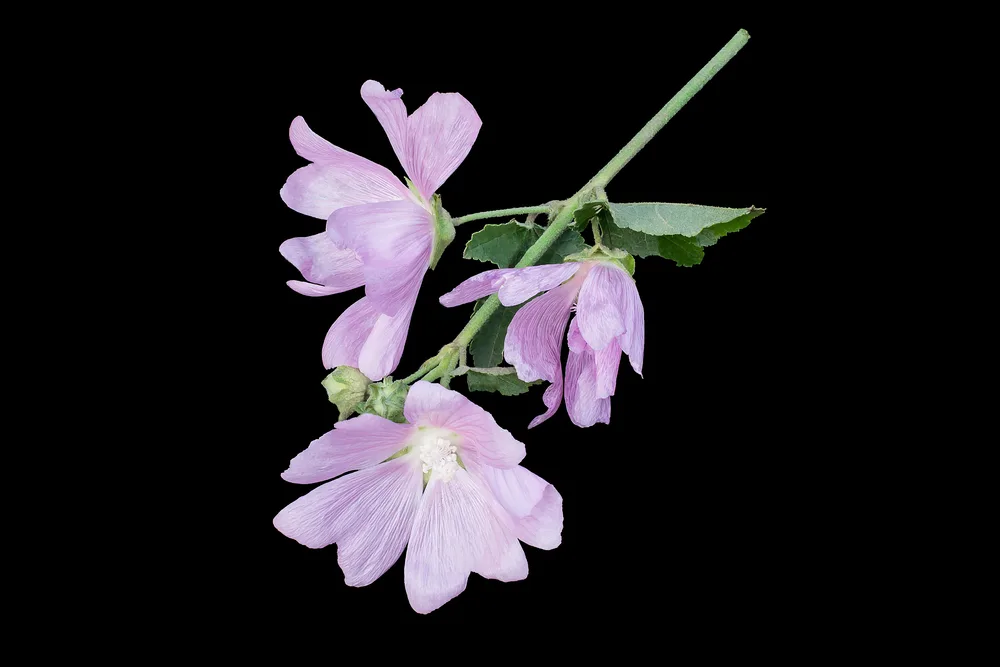
This beautiful flower is known as Malva, which means ‘mallow’ in Latin. Its unique scent comes from the specific epithet: moschata – derived from a musky-smelling herb.
Mallow is the perfect addition to any summer garden! Its striking pale pink, saucer-shaped blossoms will bloom from early in the season until fall on tall and elegant stems.
Surprisingly, the leaves of mallow are not only edible but also feature a unique sour flavor! In fact, some Bible versions even refer to it as “salt herbs” or “saltwort” in recognition of its distinctive taste.
Musk mallow is an exotic springtime beauty hailing from Europe, southwestern Asia, and northwestern Africa! This short-lived herbaceous perennial loves to make its home in dry fertile soils – a great flower in the Bible for your garden.
Musk Mallow is like a distant cousin of the hibiscus, as they both belong to the Malvaceae family. This big and diverse clan has some other interesting members, too – from cotton, okra, and even cacao!
This bushy plant features an impressive set of sturdily-built, hairy stems that spread out in multiple directions! A very impressive addition to a biblical garden!
The lower leaves are like hairy hands, reaching up to six inches long. Meanwhile, the upper leaves show off delicate divisions of five or seven segments creating a beautifully textured look.
These gorgeous saucer-shaped flowers are as soft and petal-perfect as they come. A stunning rosy pink hue graces the 2 -2 ½ inch wide blooms, with satiny notched edges that add a beautiful dimension to their eye-catching shape! A perfect colorful addition to your biblical garden!
Both flowers and foliage are musk-scented.
The Musk Mallow does best in cool climates and often self-seeds.
This beautiful plant is like a wandering soul, with its origins in the British Isles, mainland Europe, and southwestern Asia. It’s surely an exotic beauty that can add some elegance to any garden featuring flowers in the Bible.
Uses for Malva Moschata
Enjoy the beauty of this fragrant flower while also savoring its deliciousness – it may come as a surprise, but musk mallow plants are totally edible!
Believe it or not, this one plant is a veritable health food feast! Every single part – from the roots to leaves and flowers to seeds – can be added to your diet for an all-around boost of nutrition.
Musk mallow is a remarkable plant that has been valued for centuries: not only does it boast spectacular blooms, but its medicinal properties have made it integral in traditional remedies around the world!
- Versatile and nutritious, these leafy green veggies can be added to soups as a lip-smacking thickener or cooked up just like spinach.
- Different parts of this plant possess incredible healing qualities! It’s antiphlogistic, astringent, and demulcent, which can soothe inflammation. At the same time, it acts as a diuretic to help with fluid retention issues, while its emollient property makes skin softer and more hydrated.
- Moreover, this powerhouse plant is an expectorant that can clear up respiratory congestion plus act as a laxative for digestion support – talk about multitasking! Lastly, it also serves well as a salve on cuts or bruises.
- You can enjoy the natural goodness of this plant in a variety of ways! Take its leaves and flowers to add some zesty flavor to your diet, or steep some tea with the leaves, blooms, or roots for an invigorating brew.
- The leaves and flowers of this plant are highly valued for their medicinal properties. Not only can you make a poultice to soothe bruises, inflammations, or insect bites – but drinking it is beneficial too! It’s rumored to help with respiratory system diseases as well as any digestive or urinary tract inflammation.
Mint (Mentha longifolia)
Mentha longifolia
“Woe to you, scribes and Pharisees, hypocrites! For you tithe mint and dill and cumin, and have neglected the weightier matters of the law: justice and mercy and faithfulness. These you ought to have done, without neglecting the others.
Matthew 23:23 (ESV)
“But woe to you Pharisees! For you tithe mint and rue and every herb, and neglect justice and the love of God. These you ought to have done, without neglecting the others.
Luke 11:42 (ESV)
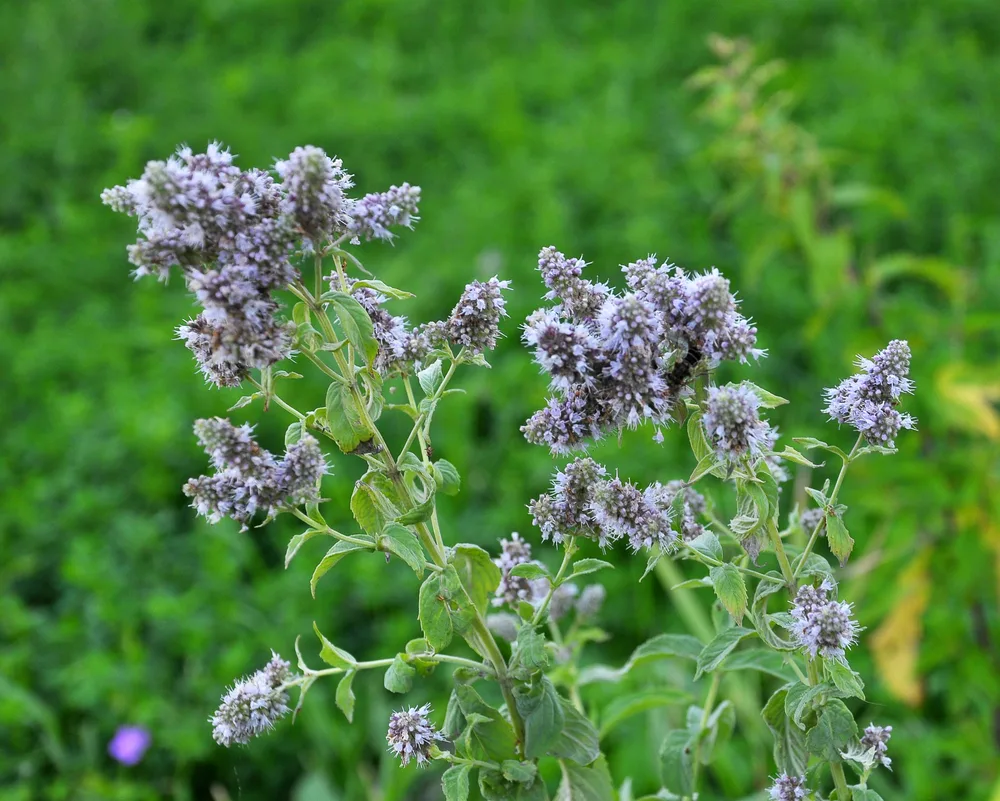
For centuries, mint has been a beloved flavor of the Middle East. This famous herb even gets an honorable mention in two books from the Bible – Matthew and Luke – when talking about tithing!
This hardy groundcover is a real show-stopper, boasting fragrant leaves and pretty pale blossoms that tower impressively over its lush foliage.
Derivation of the botanical name:
Mentha, the Latin name for mint was borrowed from Greek minthe μίνθη, whose origin is unknown.
The name for this species, longifolia, comes from Latin: ‘longum’, meaning long and ‘folium’ referring to its leaves.
Pliny’s (23-79 CE) explanation of the origin behind the use of mentha herbs dates back to ancient Greece. He proposed that because these plants had a sweet scent, it caused their name (mintha) to be changed into its modern incarnation: Mentha!
Through this, it appears that the ancient word for dung, μίνθος, was connected to mint, and its unpleasantness clashed with what everyone knew about these herbs and flowers of the Bible – their fragrance. This led to a change in the spelling of the latter term as we know it today!
It was often referred to as horse mint because the leaves are usually unpleasantly scented.
Horsemint is an amazing herb with a deep history. It can be traced all the way back to biblical times, and it’s been used for traditional medicinal purposes throughout centuries! If you’re looking to plant your own Bible garden, horsemint deserves its place amongst the herbs – just make sure not to let it run rampant.
Similar names in the Semitic languages: Arabic an-na’na’ النعناع, Aramaic nanea ܢܢܥܐ, and Hebrew nana, נענע.
With roots in Ancient Greece, the word Ήόύοσμον is translated as “mint”, and appears twice in the New Testament. Its use dates back thousands of years and continues to be a cornerstone for herbal medicine even today.
Throughout the ages, Mentha longifolia has been a favorite for flavoring dishes and medicines. Ancient cultures like Hebrews, Greeks, and Romans used this aromatic herb in their cooking as well as to aid digestion.
This wild herb hails from the distant continents of Europe, Asia, and Africa! Its native habitats include moist meadows and wetlands in northern, southern as well as central parts of these lands.
These flowers of the Bible have a way of multiplying quickly, filling landscapes with colonies that creep and grow. Reaching heights between 16-47′ tall, the stems are square in shape, and their rhizomes rapidly spread outwards.
These spectacular leaves have a delightful aroma, and come in two to four inch-long shapes. Whether they’re elliptical or lanceolate, their top side is always an inviting shade of green while the underside is white – except for its sparsely serrated edges.
Mid to late summer brings a burst of beauty with the appearance of gorgeous spikes covered in tiny white and lilac blooms. Branched, tapered, and dense with color – it’s an eye-catching display of the beauty of the flowers of the Bible.
Mint has some interesting relatives! It’s part of the deadnettle family, Laminaceae, which includes more familiar herbs like basil and sage, as well as a lesser-known one called beebalm.
With the delicious aroma and pretty flowers from mint, it’s a great one to add to your biblical garden.
Mustard (Brassica nigra)
He put another parable before them, saying, “The kingdom of heaven is like a grain of mustard seed that a man took and sowed in his field. It is the smallest of all seeds, but when it has grown it is larger than all the garden plants and becomes a tree, so that the birds of the air come and make nests in its branches.”
Matthew 13:31–32 (ESV)
And the Lord said, “If you had faith like a grain of mustard seed, you could say to this mulberry tree, ‘Be uprooted and planted in the sea,’ and it would obey you.
Luke 17:6 (ESV)
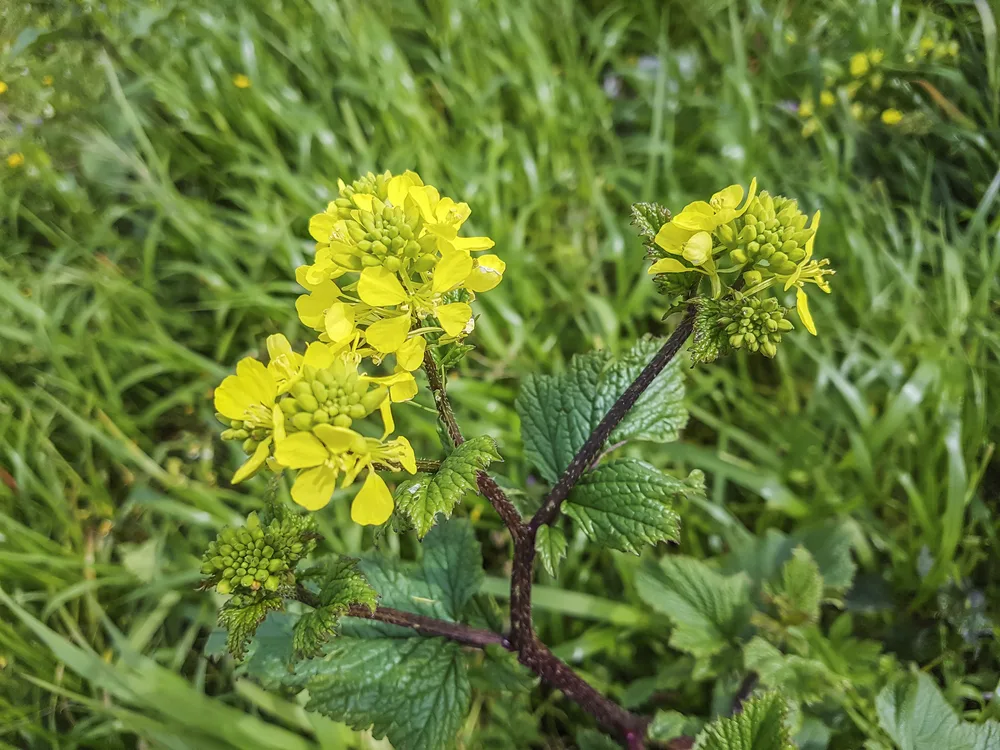
See also Matthew 17:20, Mark 4:31-32, Luke 13:19😉
Derivation of the botanical name:
Brassica is the classical Latin name for cabbage. Nigra meaning black.
The Hebrew word: כרוב שחור,cruv shjachoor, cruv, cabbage; shjachoor, black.
Did you know that the Romans get credit for creating the mustard we eat today? They were real creative, mixing ground seeds with grape juice! The word “mustard” comes from two Latin words: mustum (which is translated to ‘grape must’) and ardens (‘burning’), thus “mustard.”
The seeds of the Brassica nigra make the table mustard.
The leaves may be eaten raw or cooked. They have a hot taste but can be finely chopped and added to salads or cooked with other herbs in a pot as a potherb.
From its humble beginnings as a tiny seed, black mustard can reach up to eight feet tall and flower into bright clusters of yellow blooms each summer.
Planting mustard can tantalize the taste buds, but beware – this plant spreads quickly and easily! If you want to add it to your garden, be sure to keep a close eye on those seed pods; harvesting them before they open will help avoid an unintended takeover.
Poppy (Papaver rhoeas)
“All flesh is like grass
1 Peter 1:24 (ESV)
and all its glory like the flower of grass.
The grass withers,
and the flower falls,
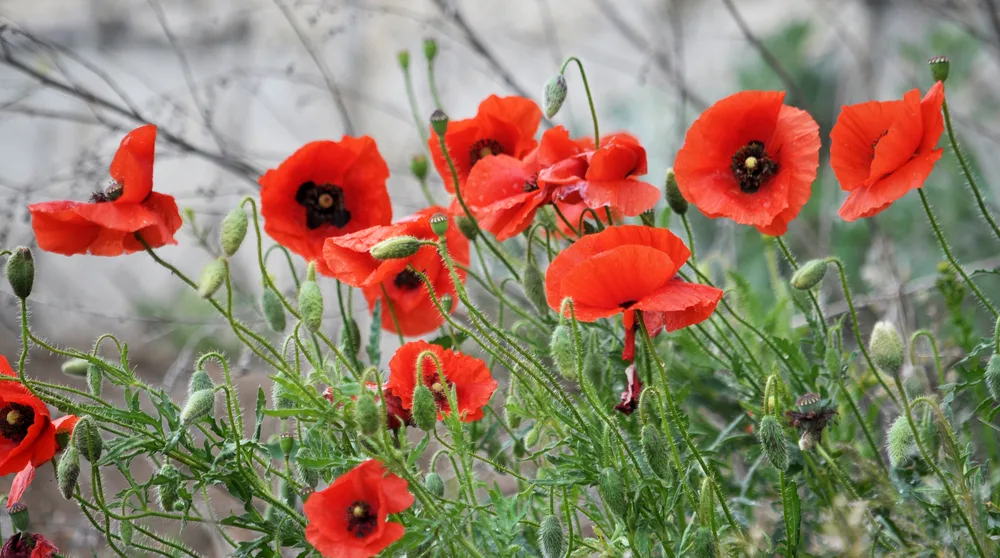
Peter’s poetic words were likely inspired by the enchanting sight of a common poppy in full bloom, its beautiful red petals fleeting yet ever so captivating.
Of all of the flowers and the symbolic meanings of flowers, this one is special to add to your Bible garden.
Derivation of the botanical name:
Papaver is the classical Latin name for the poppy. Rhoeas for wild.
The Hebrew name: pereg, פרג (sometimes parag) derives from the Sanskrit word priyangu, meaning “foxtail millet” (or “panic seed.”)
It is found in the plural – פרגין – in the Mishna (Sheviit 2:7, Chalah 1:4) and in the Talmud (Rosh Hashana 13b), listed together with other crops that aren’t full grains like shumshum שומשום – sesame and orez אורז – rice.
Crossbreeding is commonplace among Papaver rhoeas P.carmeli, P. humile, and P. umbonatum – species that have happily intermixed to create dazzling new varieties of poppies.
These annual flowers come alive during late spring, reveling in sun-filled afternoons. Plant them from seed when temps start cooling down, or wait until fall if you live somewhere with warmer weather.
Planting your seeds is made easier when you start with a level and debris-free soil bed. Be sure to give them the right amount of cover, then press lightly into the dirt – just enough so they won’t blow away! Keep it moist while nature takes care of rest; that’s all there is to growing lush plants from tiny little seeds.
Rose (Rosa canina) Dog Rose, Wild Brier
Derivation of the botanical name:
Rosa, an ancient Latin name whose meaning has been lost. Canina, of or pertaining to a dog; canine, of dogs.
The Hebrew word Vered, וֶרֶד, Greek: rodon; Aramaic: Varda; Arabic: warad, ورد .
The Hebrew word hakelev, הכלב, is a translation from the scientific name canina, dog.
Uses for Rosa Canina
“Rosa canina — Dog Rose, Hiprose, Canker Flower, Dog Briar, Cynosbatus [dogs’ bush] (also called oxyacantha) is a shrub much bigger than a common bush — almost the size of a tree.
It bears leaves a great deal broader than myrtle and has strong hairs around the sprigs, white flowers, and somewhat long fruit like the kernel of the olive. When this is ripe, it grows red, and the stuff within is downy.
The dried fruit stops discharges from the intestines (the downy stuff of it is taken out for this is worthless for the arteries). It is made hot in wine and taken as a drink”.
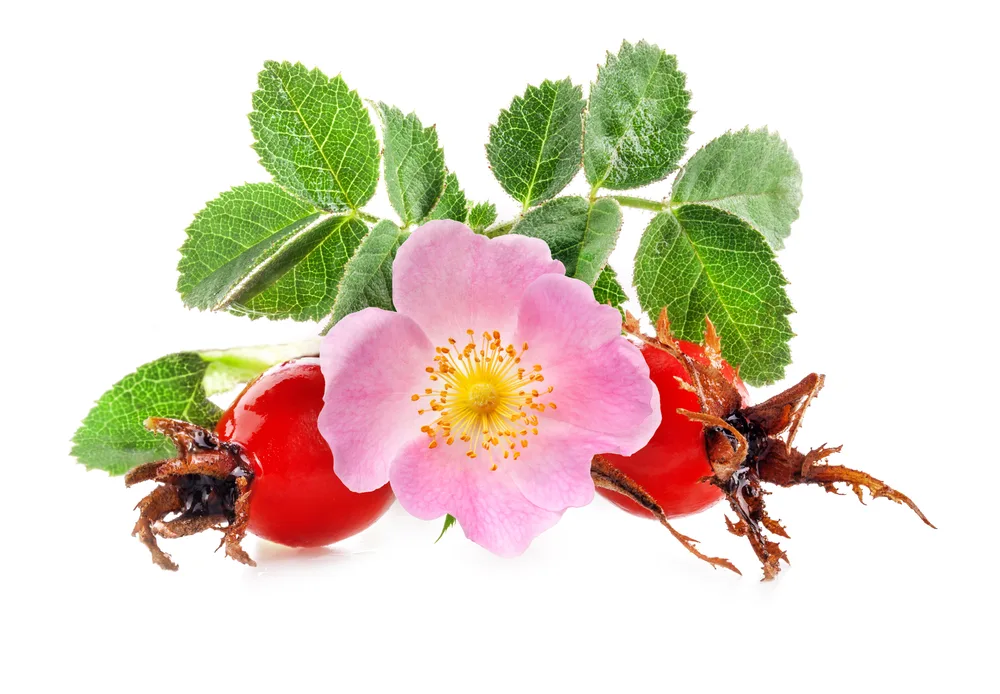
Dioscorides (ca.40- ca.90 CE.) writes in his Materia Medica.
- The Dog Rose has a secret – its hips are packed with vitamins that your body loves! They’re easily absorbed, so indulge and enjoy the health benefits.
- Rose hips are an incredibly valuable source of Vitamin C, so much so that they were used to make syrup during World War II! Not only can you get a hefty dose of vitamin C in every serving, but their flavor is truly unique and pleasant.
- Despite their lack of modern medical advances, ancient Romans had an interesting solution for rabid dog bites – Rosa canina! It was actually used as far back as the first century CE.
- Ancient Egypt was known for its love of roses! Queen Cleopatra adored the captivating flowers and enjoyed decorating her royal chambers with them.
Biblical Symbolism of the Rose
A rose is more than just a beautiful flower – it’s also a symbol of faith in many religions. In Christianity and Catholicism, its significance carries powerful messages about love, courage, hope, and God’s unconditional mercy.
Catholics look to the rose as a representation of their devotion in prayer. The rosary, composed of beads and symbols such as the rose, is used by Catholics during contemplation or special holy days – like when honoring Jesus’ birth, death, and resurrection.
Christianity has a special way of remembering the sacrifice Christ made – five petals on a rose represent his wounds that resulted from crucifixion. It’s an engaging reminder of how far he was willing to go out of love for us all!
Did you know a rose’s color carries special significance? White roses stand for Christ’s purity, and red symbolizes his sacrificial blood. But put them together, it represents the ultimate sacrifice – Jesus’ crucifixion and resurrection!
Of course, we would want to add the beautiful rose to our biblical gardens!
Rue (Ruta chalepensis)
“But woe to you Pharisees! For you tithe mint and rue and every herb, and neglect justice and the love of God. These you ought to have done, without neglecting the others.
Luke 11:42 (ESV)
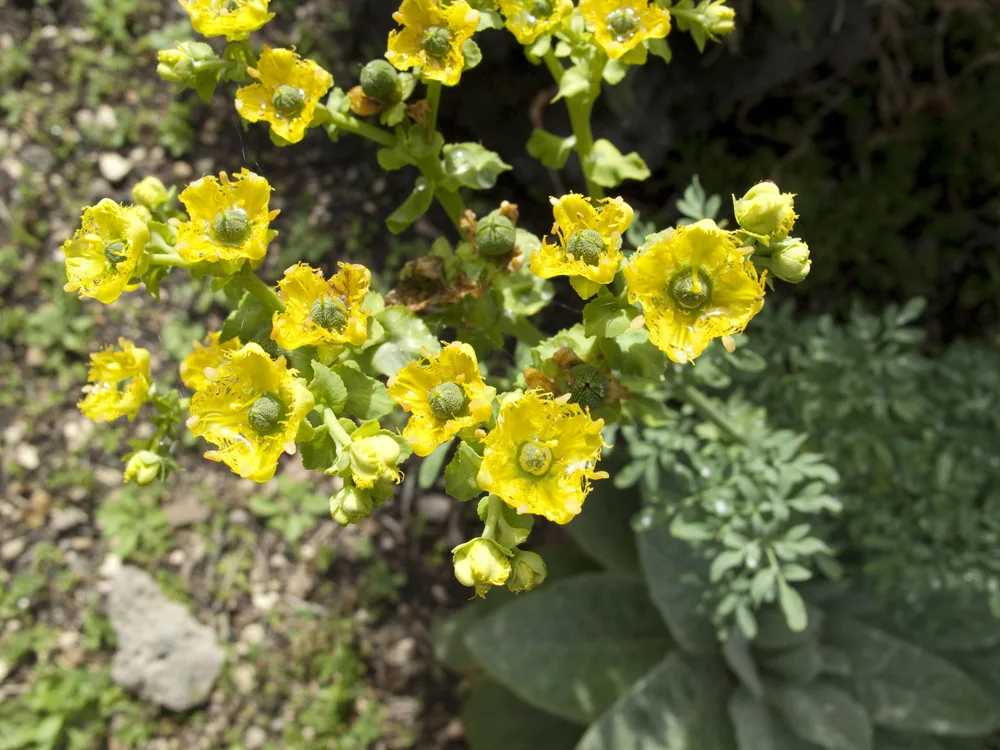
Jesus once referenced a mysterious herb known as rue when delivering teachings – but it’s even more than meets the eye! It appears in tea and seasonings across the Middle East, where it continues to be widely cultivated.
Ruta chalepensis is a wild species of rue native to the Mediterranean region, making it likely that this was what Jesus referred to as he spoke with his disciples. Those familiar with its close relative R. graveolens, will see many similarities in both appearance and habit
Derivation of the botanical name:
Ruta (Latin), borrowed from Greek rhyte [ῥυτή]. The origin of the (originally Greek) name Ruta is unknown.
Ruta may derive from the Greek ‘rhutos,’ “shielded,” in view of its long history as an antidote.
Chalepensis, of or from Aleppo in northwestern Syria.
The Hebrew name פיגם, Pigam, from Greek peganon; often post-biblically as pigam, closely cognate with the Arabic fegam.
“They may not graft rue on white cassia, since that is [grafting] a vegetable on a tree” (A rue is a shrub, which falls in the vegetable family (according to rabbinic classification, of course) and a white cassia is a tree. Thus grafting the two together is prohibited.
Pigam appears in the Mishnah, Kil’ayim ( prohibitions) A 8
In Biblical times, gardeners weren’t just tending flowers or veggies–they were also potentially making contributions to the government’s coffers. Plants from cultivated gardens could be taxed or tithed as part of an ancient legal system.
In the Old Testament, there was a special exemption to paying taxes on Rue – this fragrant herb that wasn’t just used in cooking but also grown from its natural state.
During the time of Jesus, gardeners were tithing their crops – such as those found in home gardens.
Uses for Rue
In the days of Ancient Greece and Egypt, rue was a go-to herb for all sorts of ailments – from menstrual bleeding struggles to improving eyesight.
Growing Rue
This hardy perennial herb adds a touch of sunshine to every garden with its brilliant yellow flowers and soft gray-green leaves.
Plant your foliage with care, letting the gentle green tangle among beds of beautiful flowers and herbs. But make sure to keep them back from any walkways you may have – their leaves contain substances that can cause painful skin reactions if touched by sunlight!
If you’re looking for a hardy, low-maintenance plant to add some greenery to your space, rue is the way to go! You can transplant from 4” pots, and grow directly from seed or even root cuttings – making propagation simple and straightforward.
When planting an herb garden, it’s a good idea to keep rue away from the minty crew—basil and sage. It seems compounds in rue can stunt their growth!
Pruning flowers can be a great way to keep your garden healthy and vibrant – so snip them off soon after they appear, allowing energy to focus on its lush foliage.
Saffron (Crocus sativus)
nard and saffron, calamus and cinnamon,
Song of Solomon 4:14 (ESV)
with all trees of frankincense,
myrrh and aloes,
with all choice spices—
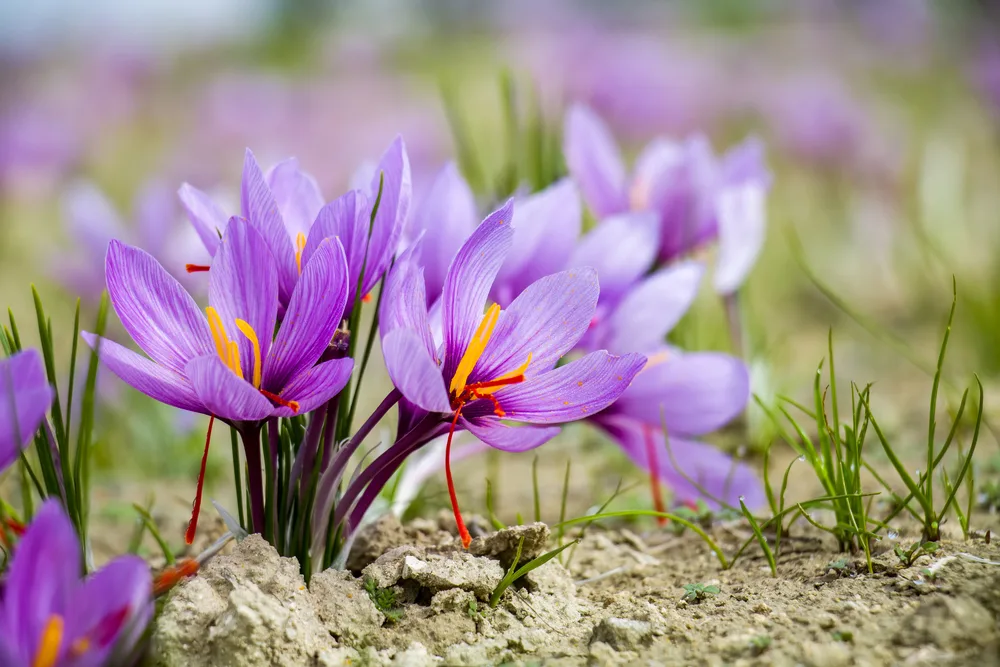
Identical to the Arabic kurqum, the same as za`faran, “saffron.”
The prized saffron spice originates from the Crocus sativus plant, a member of the Indaceae family which is cultivated in Palestine. Interestingly enough, there are 8 wild varieties that also produce this yellow dye, saffron.
Song of Solomon 4:14 probably refers to the C. sativus.
Each Saffron flower is a beautiful reminder of the Holy Trinity! Each bloom showcases three distinct yet intertwined stigmas, symbolizing the Father, Son, and Holy Spirit.
Uses for Saffron
- From the heart of its blooms, the pistils and stigmata are transformed into saffron cakes – a popular delicacy in Eastern culture.
- Saffron, a useful traveling flower, is a powerful condiment that packs a punch of flavor and adds charm to any meal. A small pinch can turn an ordinary dish into something special – like adding some flavor atop bland rice or flavoring stews!
- As the flower stigmas dry, they shrink and look like “threads” – the commercial name for the spice, Saffron.
- Since antiquity, saffron has captivated people with its exotic aroma and luxurious reputation. It’s no wonder that it was treasured as an ingredient in perfume for many ancient cultures!
- Not only does this natural plant have healing properties, but it can also spice up your dishes and lend a vibrant hue to fabrics – making it an incredibly versatile ingredient.
- No dish is complete without the perfect pinch of saffron – approximately 10 flowers will give you just enough for a flavorful rice dish that serves 4.
Growing Saffron
With elegant light blue flowers, saffron is not just a stunning type of crocus – it’s also the source of one of the world’s most expensive spices and a beautiful, surprising addition to a Bible garden.
- The Saffron crocus are fall-blooming bulbs and are best to plant late to the end of summer.
- Pick a spot to plant so you can revel in the beauty of their late-season blossoms, and remember to reap the rewards – literally! Once it’s blooming, ensure not to miss out on harvesting those stigmas.
- Give your new bulbs a healthy start with bone meal – it’s the perfect fertilizer for a strong, beautiful bloom!
- Planting saffron is an investment that pays off: in two months, you can start to see the first green shoots, then three weeks later, delight yourself with beautiful blooms.
- If temperatures start to dip, it’s a good idea to bundle up your saffron crocus plants with a cozy blanket overnight. While the first frost normally won’t cause any harm, if you want those beautiful blooms around for longer than 25 degrees is the cutoff!
- After putting on its show of beautiful blooms, plants in this family will lay dormant over the winter before regrowing and dazzling us all with their beauty come springtime.
- Remember where the bulbs planted in fall will be when next year comes around! If left undisturbed, each autumn, you’ll find more and more of them blooming.
Tulip
Derivation of the botanical name:
Tulipa, is from the Persian word “thuliban” or “dulbend”, meaning “a turban”. This evolved into the Turkish “dulbend” and “tulbend, Latin “tulipa” and English “tulip”. Systola, Greek systole, contraction.
The tulip is assigned to the group of spring flowers referred to in the Holy Land as titanium (red flowers). The name tulip probably comes from turban (tulbana – tur.). In Israel, Tulipa amplyophylla and Tulipa Montana occur naturally.
Tulips are a beautiful way to represent spiritual awakening – with their annual return from bulbs, they signify rebirth and an unyielding spirit.
Tulipa Montana, one tulip species (Hebrew, possibly nitzanium) native to Turkey, Syria, and Palestine, continues to grow wild in the region; However, tulips are commonly associated with the Netherlands after the “tulip mania” of the 1600s, when the genus was imported and preposterously propagated.
A member of the Liliaceae family, tulips sprout several elongated pale green leaves during the late winter or early spring rains. A central stem with a solitary, prominent tightly-cupped blossom emerges, growing to about 12 inches tall. The folded bud, faintly colored, was thought to resemble a man’s turban-wrapped head; the name tulip is a derivation of a turban.
As the flower petals open, their color becomes more vibrant. Tulipa Montana is a bright red flower with a black center.
After blooming, the bulbs, or geophytes, show their adaptation to Mediterranean dry summers by reserving nutrients in the fleshy underground bulb, allowing leaves to wither, remaining dormant in the dry season.
Tulips cover the mountainsides along with other wildflowers in Asia Minor and the Mediterranean area; though Paul did not describe the flower-filled fields in which he journeyed, tulips may be referenced as spring “flowers” in the Old Testament (Song of Songs 2:12).
—excerpt from NIV God’s Word for Gardeners Bible
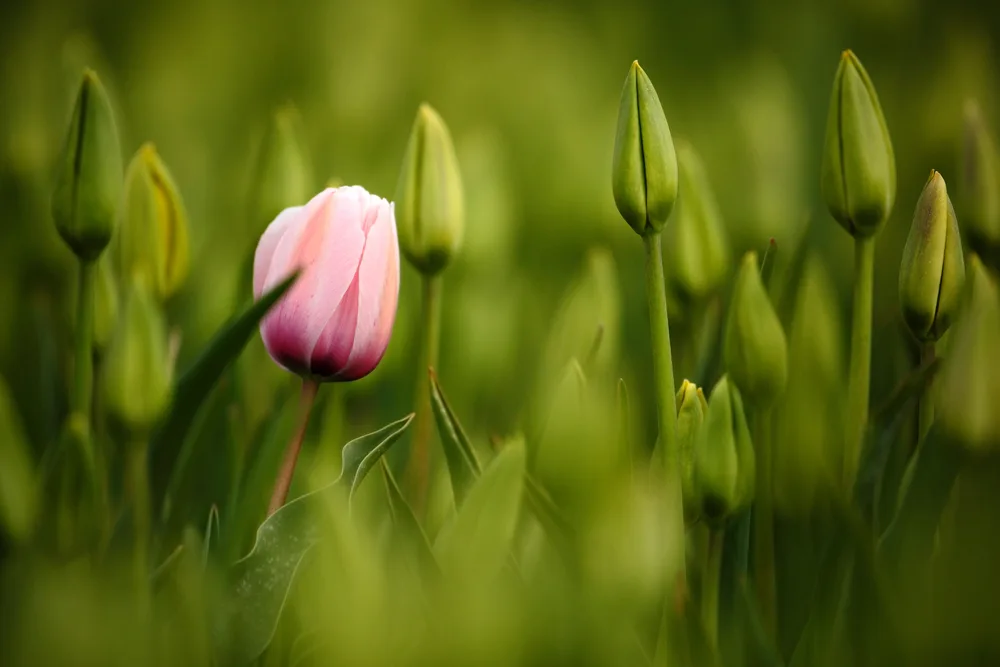
Tulips are not singled out by name in the Bible. However, most scholars are confident that tulips filled Scripture’s spring scenery, especially as relayed in the collection of wildflowers “appearing on the earth,” (Song of Songs 2:12) at the end of winter’s rainy season.
Why not add it to your Bible garden for a pop of color?
‘Madame Lefeber’ red tulips
‘Madam Lefeber’ Tulips resemble the wild tulips of Israel, with bright red petals with yellow and black centers.
Today. wild tulips springing up across the uncultivated fields of Israel are generally shorter than our garden hybrids, and most all are colored vivid red. Contrasting black and yellow centers display as the flowers unfold and fade. Tulipa systola and Tulipa sharonensis are a few of the noted species growing in the holy land, though not easy to locate commercially. They are cherished as part of the “Nisan” springtime sequence of red floral profusion that delights citizens of the Middle East, kicked off with crown anemones and culminating in poppies.
Uses for Tulips
- Tulip petals are believed to have a range of medicinal values, from soothing pesky insect bites and stings to relieving itches and skin irritations. However, some people might experience skin irritation when using the flower as a poultice, use it with caution.
- Tulip sap has diuretic and antiseptic properties, which makes it helpful in treating coughs and colds. In some areas like Afghanistan, the root of this flower is even eaten for strength-giving benefits.
- Tulip flower essential oil is said to be a luxurious skin moisturizer.
- They make a fantastic natural blush. Crushing and rubbing the petals on your skin is an easy way to add some beautiful color while concealing any blemishes.
- During World War II and the famine of 1944-45 in Holland, one of the darkest periods in Dutch history, people were driven to desperate measures – even turning to tulip bulbs for sustenance. During the famine, consuming flowers became a grim reality as citizens had no other choice but to do whatever they could just to survive.
- They even ground the bulbs into flour to make bread.
- When selecting tulips for culinary creations, it’s important to be mindful – only the petals should ever make their way onto your plate. The other parts of the bulb have an unwelcomed side effect: they can be toxic.
- Get creative in the kitchen with sweet tulip petals – they give salads an extra burst of flavor and color. Plus, try using them as a unique holder for your chicken or other greens.
VIOLET
Derivation of the botanical name:
Viola, a classical Latin name for violets. odorata, odoro, to smell, give off a fragrance, be perfumed; scented.
Hebrew poet Saul Tchernichovsky translated the Russian folktale of Ivan and Maria into Hebrew, changing their names to Amnon and Tamar. This poetic transformation was made possible by his knowledge of both languages – Hebrew (סגל, segal) and Aramaic ( סיגלא , sigla).
This is an upsetting account from the Bible, with Amnon taking advantage of his own sister Tamar. Out of this darkness sprung a lasting reminder in the form of a flower – today known as ‘Amnon and Tamar’ in remembrance.
Violets may also be interpreted as Mandrakes.
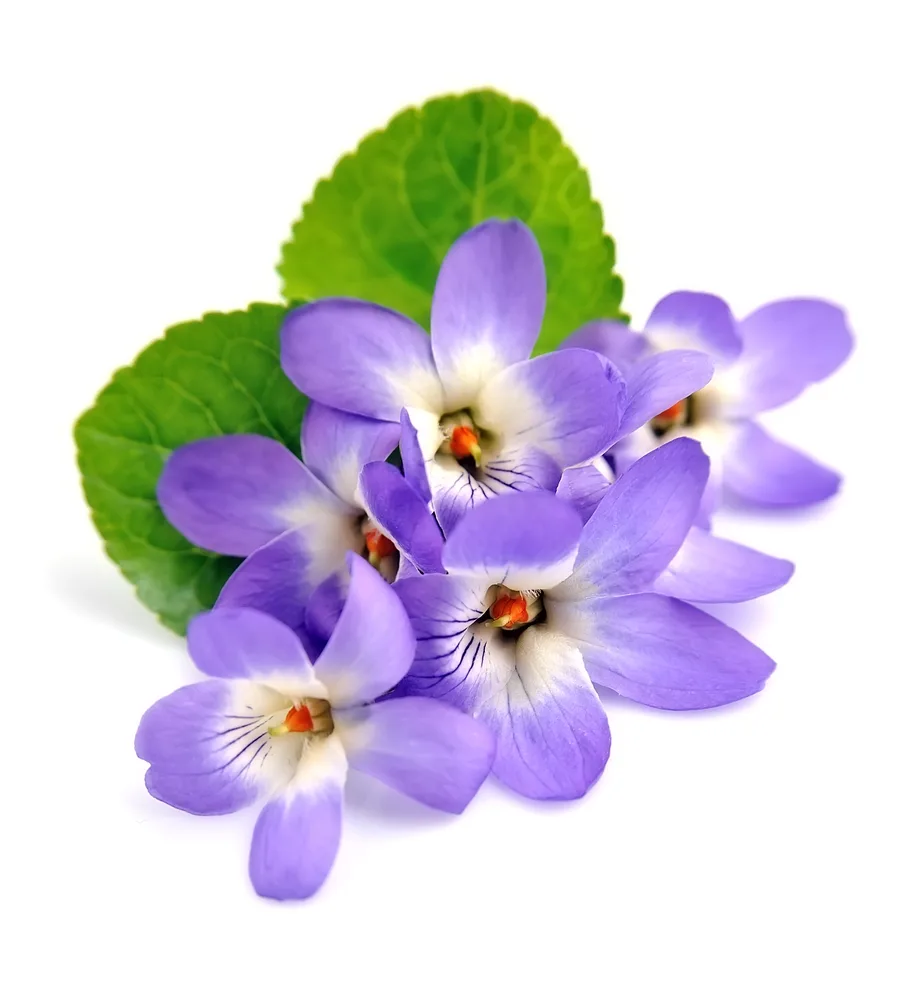
In the days of wheat harvest Reuben went and found mandrakes in the field and brought them to his mother Leah.
Genesis 30:14-16 (ESV)
Then Rachel said to Leah, “Please give me some of your son’s mandrakes.”
But she said to her, “Is it a small matter that you have taken away my husband? Would you take away my son’s mandrakes also?” Rachel said, “Then he may lie with you tonight in exchange for your son’s mandrakes.”
When Jacob came from the field in the evening, Leah went out to meet him and said, “You must come in to me, for I have hired you with my son’s mandrakes.” So he lay with her that night.
Many interpretations have been given of this word dudaim. It has been rendered “violets,” “Lilies,” “jasmines,” “truffles or mushrooms,” “flowers,” the “citron,” etc.
Botanists regard the Mandragora officinalis as a close cousin to their well-known nightshades family, including that infamous “apple of Sodom” and humble potato plant.
It is said that the violet/mandrake has a double-edged power – it energizes, yet also sedates.
This charming plant produces a delightfully soft, pale orange fruit. It’s about the size of a potato apple and has earned itself an appropriate nickname – ‘love apple’.
The Arabs refer to it as “Satan’s apple.”
The violet continues to grow near Jerusalem and in other parts of Palestine.
We should look to the vibrant color of violets as a reminder that we must continually strive for spiritual renewal. This is what our Beloved desires, and if we allow Him to lead us among His lilies, He will keep us nourished and refreshed.
Uses for Violets
The Romans really knew their way around the vine! They crafted a truly unique wine, made with sweet violets and bursting with flavor. Plus, they added different botanicals like rose petals or iris roots at various times of the year to make it even more special.
While there are some contradictions between biblical botanists on this flower, it was my mother’s favorite flower and is definitely part of my plan for my own Bible garden.
While we may not have a definitive answer as to what “lily of the valley” or “rose of Sharon” actually were in biblical times, modern science has made some educated guesses about which flowers these mysterious monikers could be referring to.
Aside from the fig tree and vine, there are also numerous other plants mentioned in Biblical translations. Get ready to be surprised by wheat, olives, oil olive trees (yes – they’re different!), cedars of Lebanon…and more!
- open flowers
- cluster of henna blossoms
- flower of the field
- Passion flower
- almond blossoms, almond flowers
- dry grass
- flower of the grass
- wild flowers
- lily blossom
- olive tree
- branches of palm trees
- sweet flowers
The form you have selected does not exist.
Planting and nurturing a biblical garden is an excellent way to cultivate your passion into a powerful spiritual practice.
Add a touch of divinity to your biblical garden by bringing in some stunning blooms from this divine list of flowers in the Bible. Before planting, check out the post on flowers in the Bible and their meanings, as well.
From the fragrant lily of the valleys to breathtaking anemone blooms, Scripture abounds with captivating displays of floral splendor.
These stunning flowers are here to remind us of God’s love – a beautiful gift in everyday life.
If you’re looking for a serene way to start your day, why not spend some time in your vibrant Biblical garden? Set aside the morning and find peace as the sun rises – it’s an amazing opportunity to pray or read your Bible.
Flowers have held sacred significance throughout the ages, and Christianity has been no exception. The Bible – both Old and New Testament books – include many references to blooms as symbols of hope, love, or new life.
Think of it – for thousands of years, people have been admiring the same petals and aromas we do today. It’s incredible to know that some flowers which bring us joy are the same flowers enjoyed in biblical times.
From fragrant spring blooms and aromatic spices to the delicate lilies of the field and the majestic rose of Sharon – it’s a beautiful reminder that God’s love is immutable. No matter how much our world changes around us, His never-ending affection will remain constant.
Are you in need of a reminder that life is beautiful? Look no further than the petals of each flower: God’s love shines through these vibrant and captivating blossoms. Allow their beauty to touch your soul every day, enhancing your well-being with its splendor! Flowers are our divinely-sent reminders; be thankful for them today.
Don’t have a green thumb or room to plant a biblical garden? Check out this video on “growing” your own biblical garden through a version of Bible journaling!
Are there any flowers you would add to the list? Do you currently have your own biblical garden?
ESV – “Scripture quotations are from The ESV® Bible (The Holy Bible, English Standard Version®), copyright © 2001 by Crossway, a publishing ministry of Good News Publishers. Used by permission. All rights reserved.”

